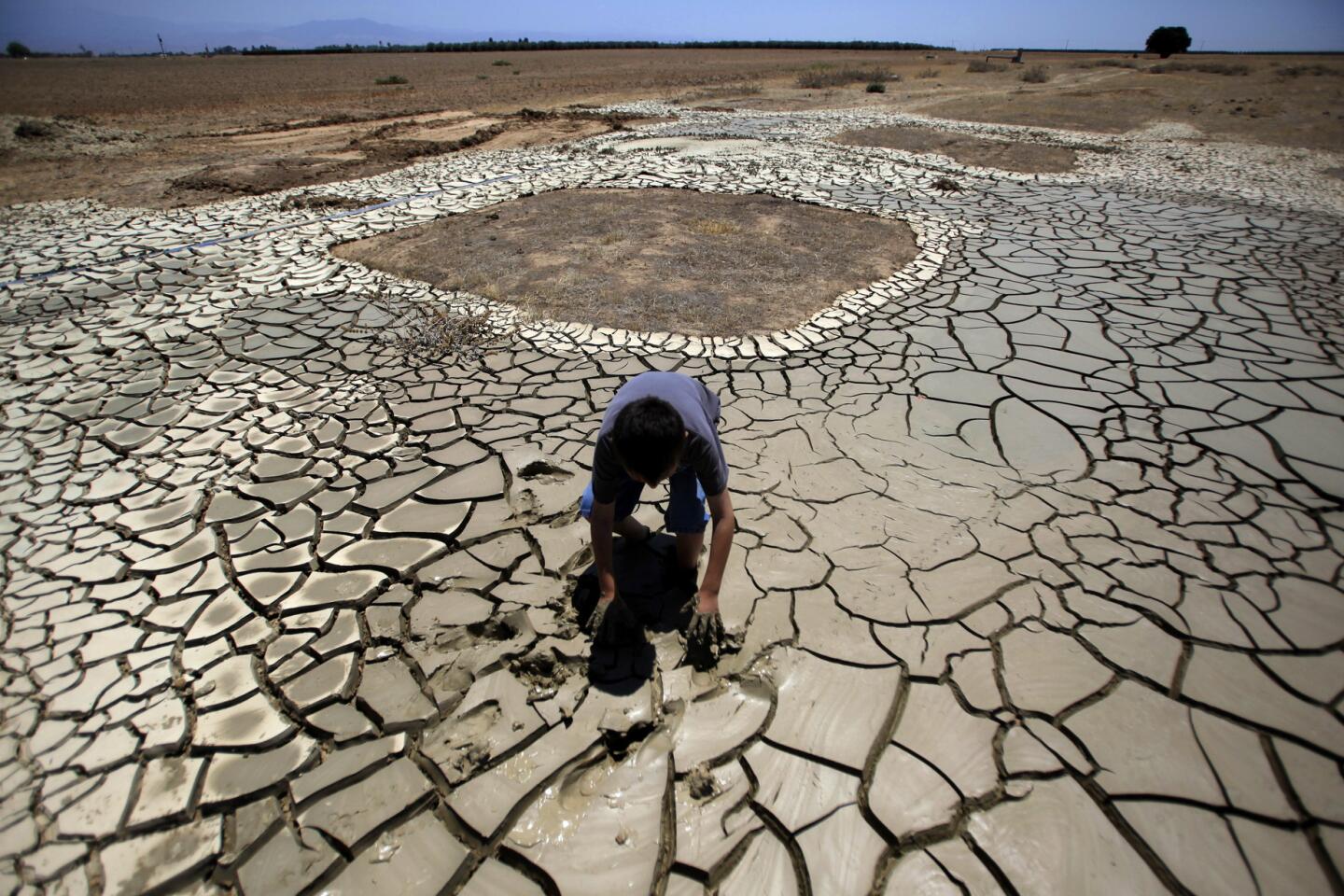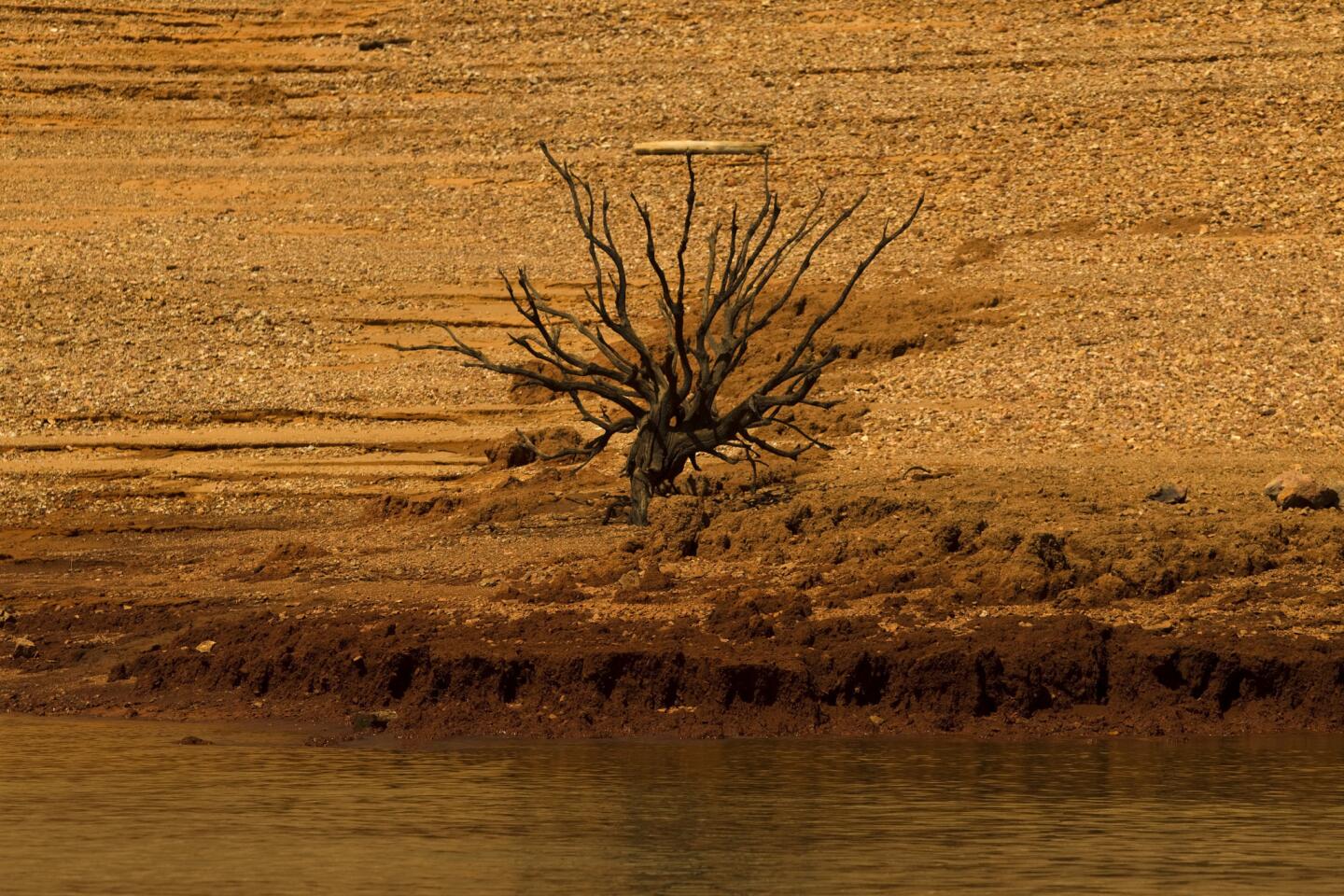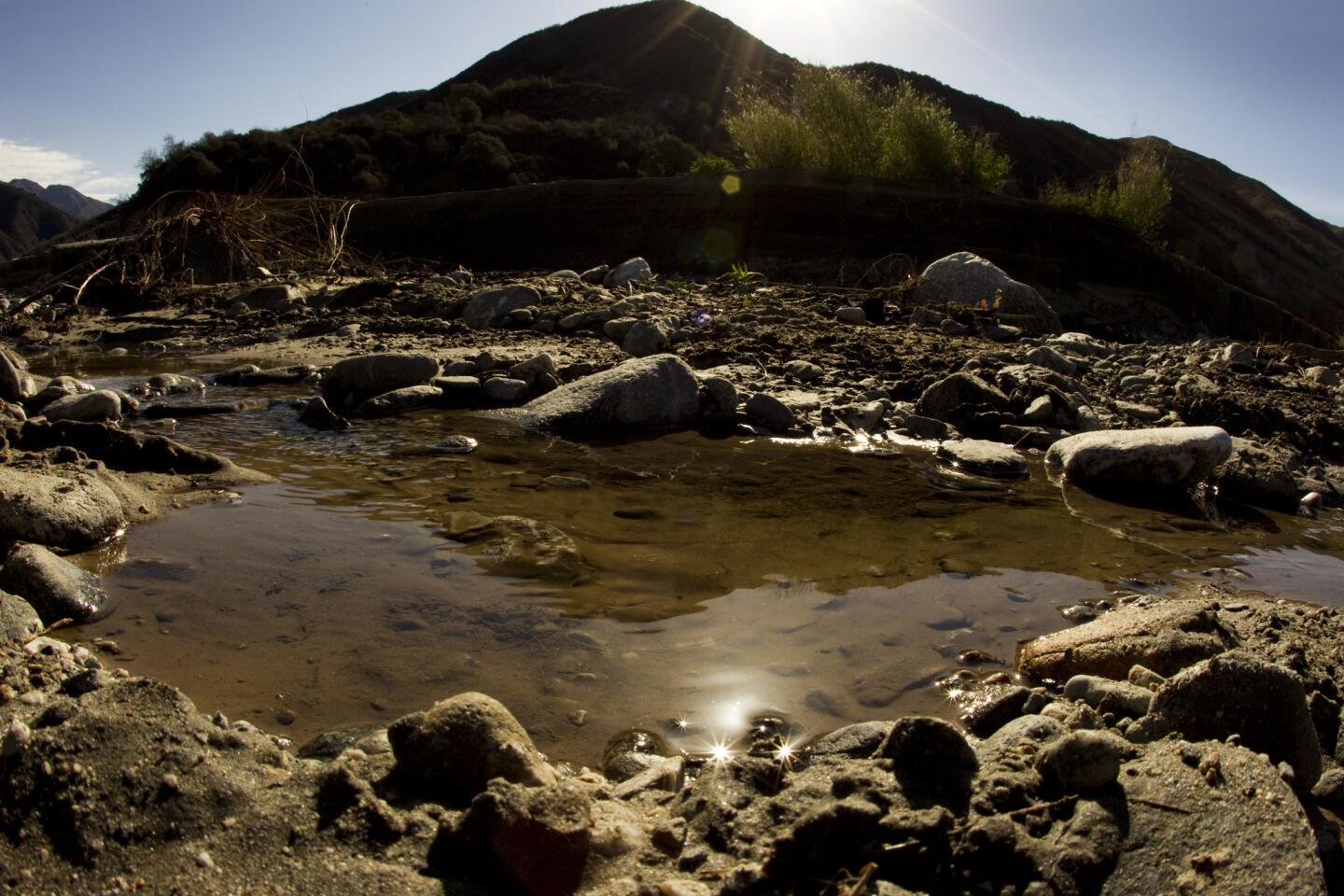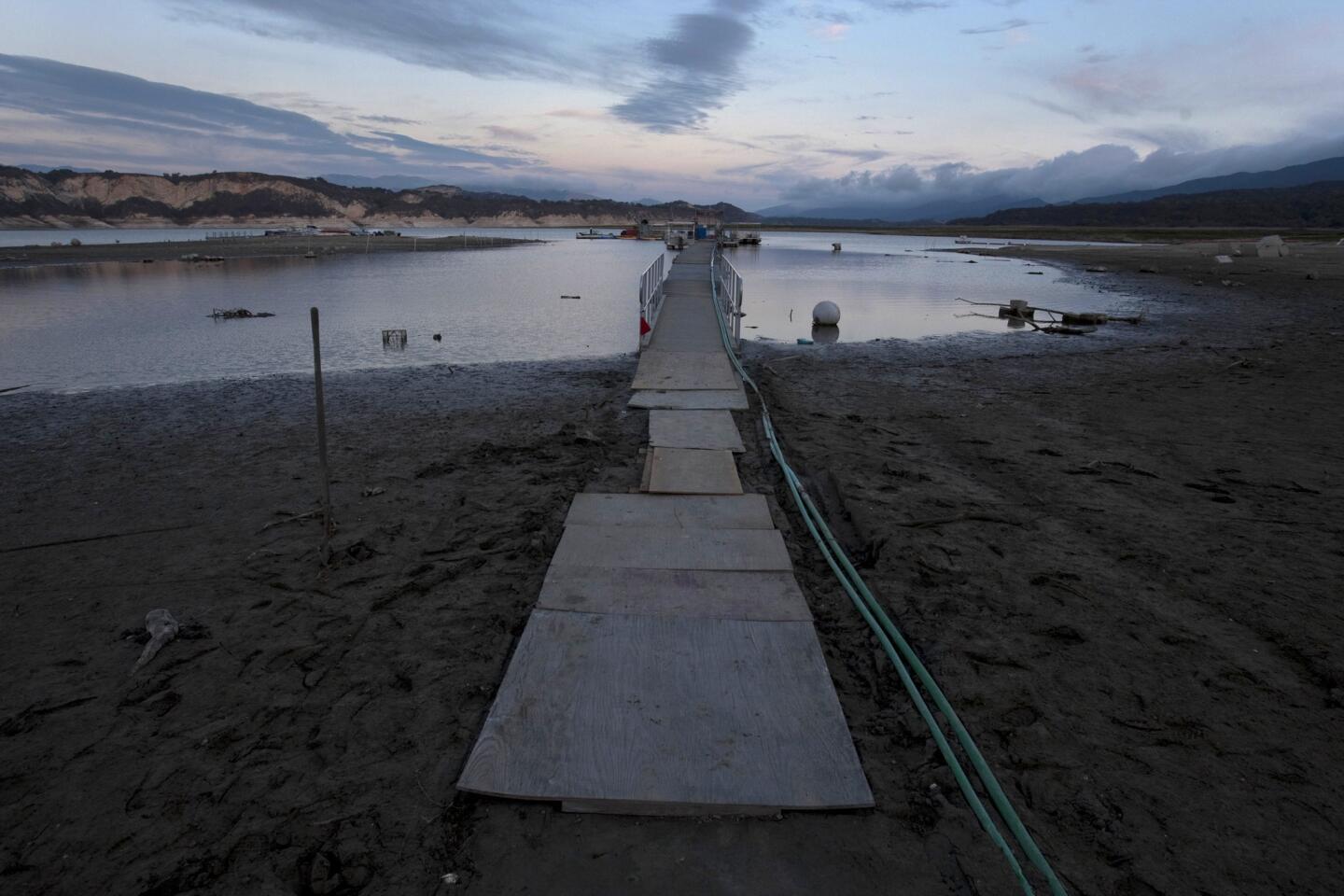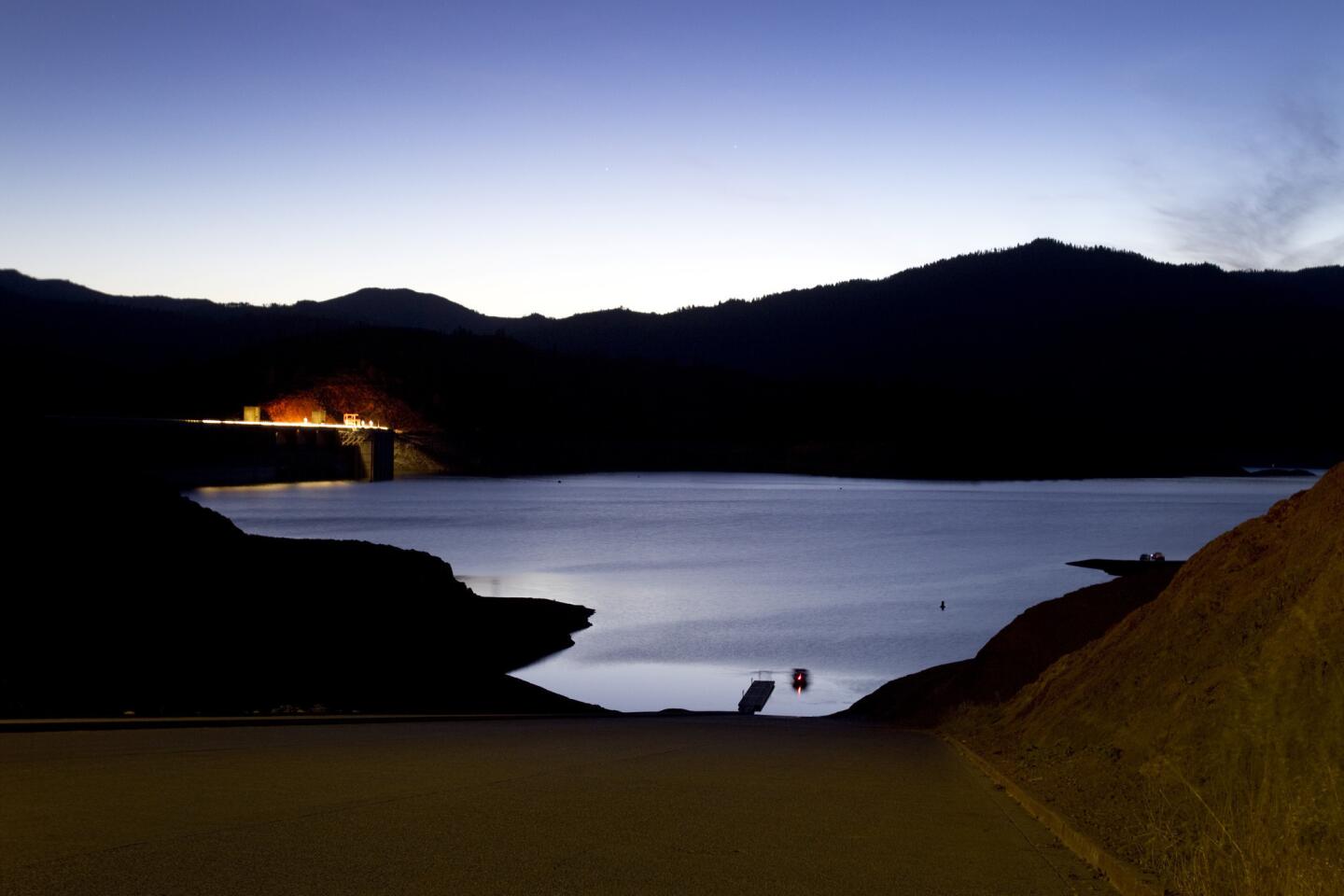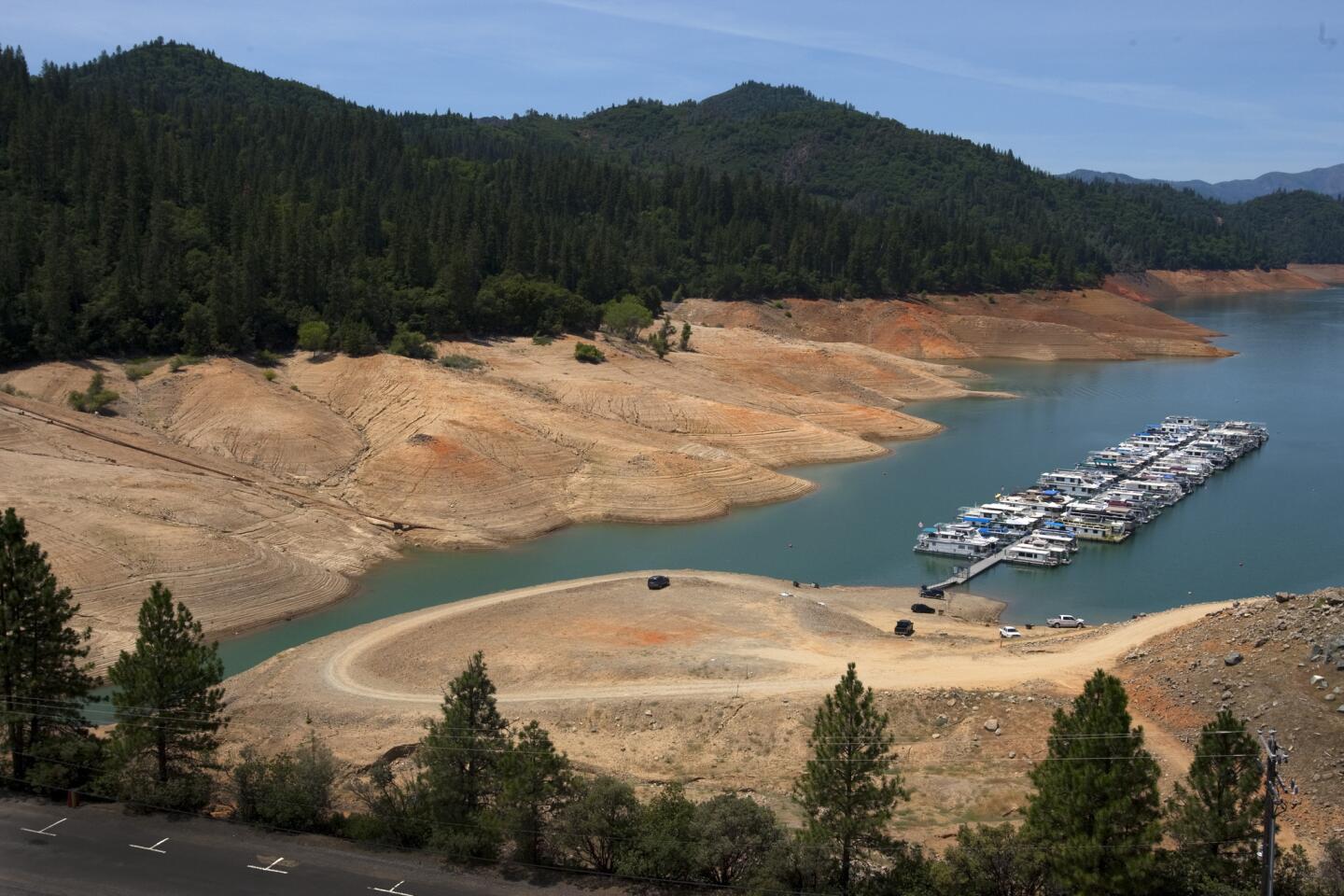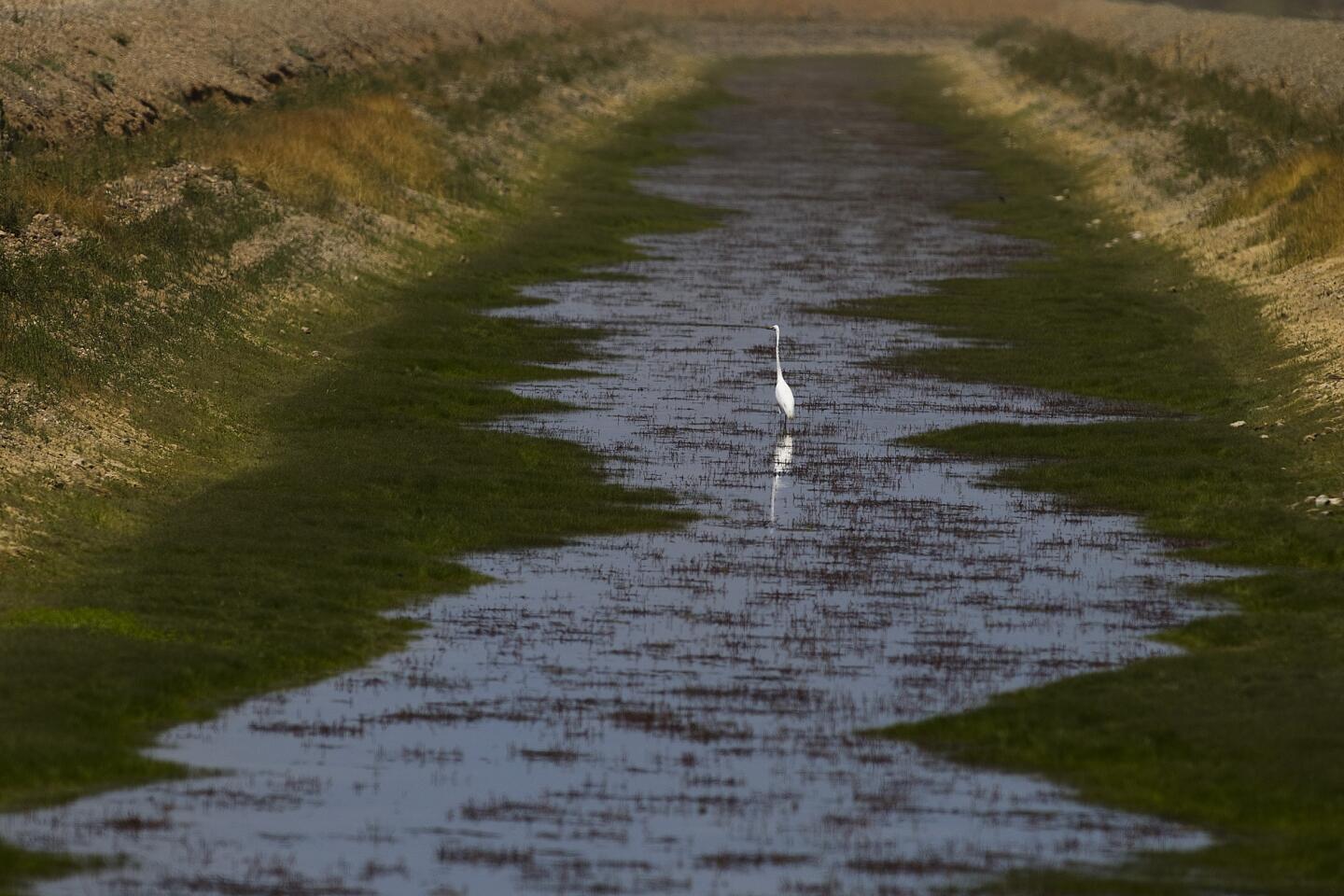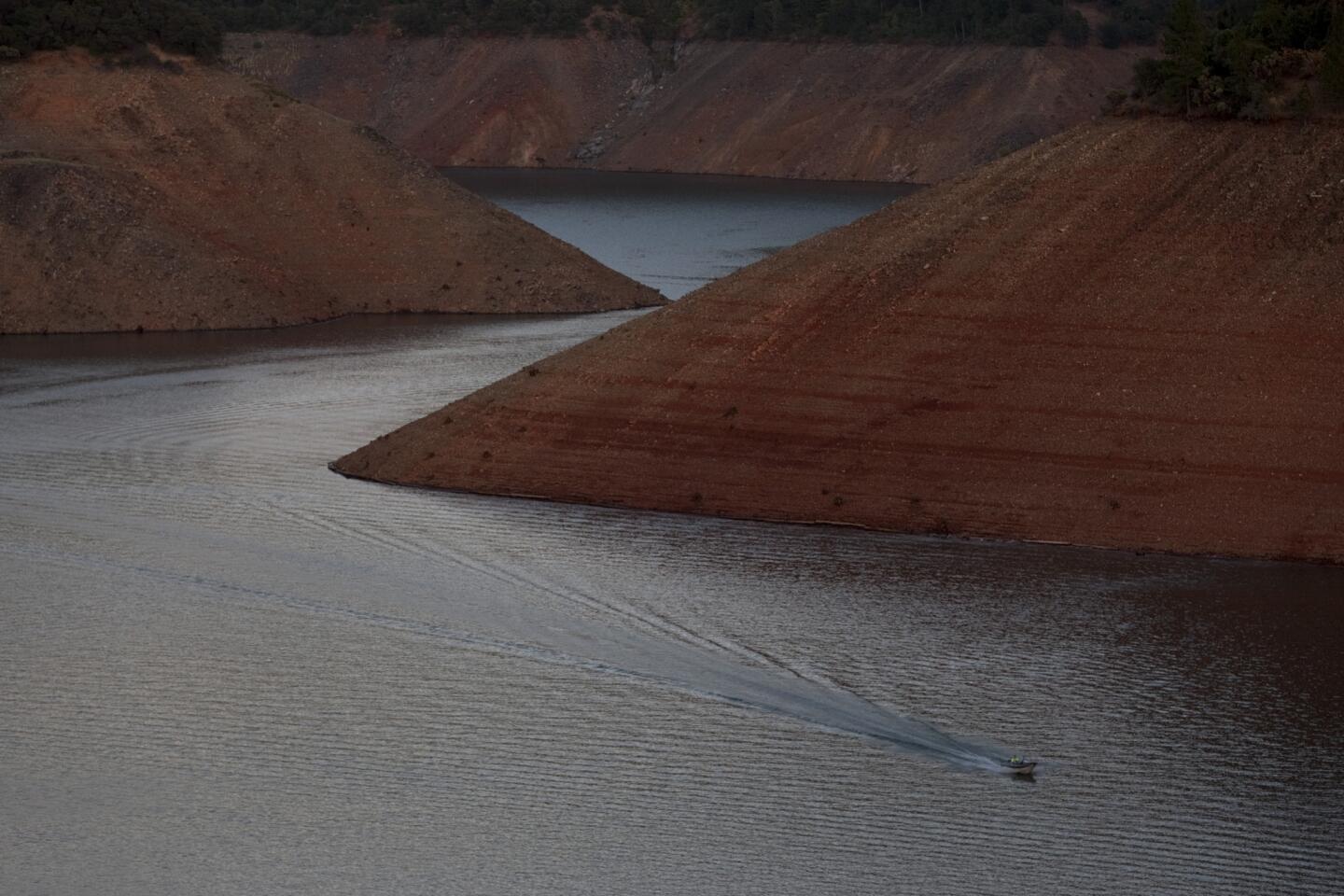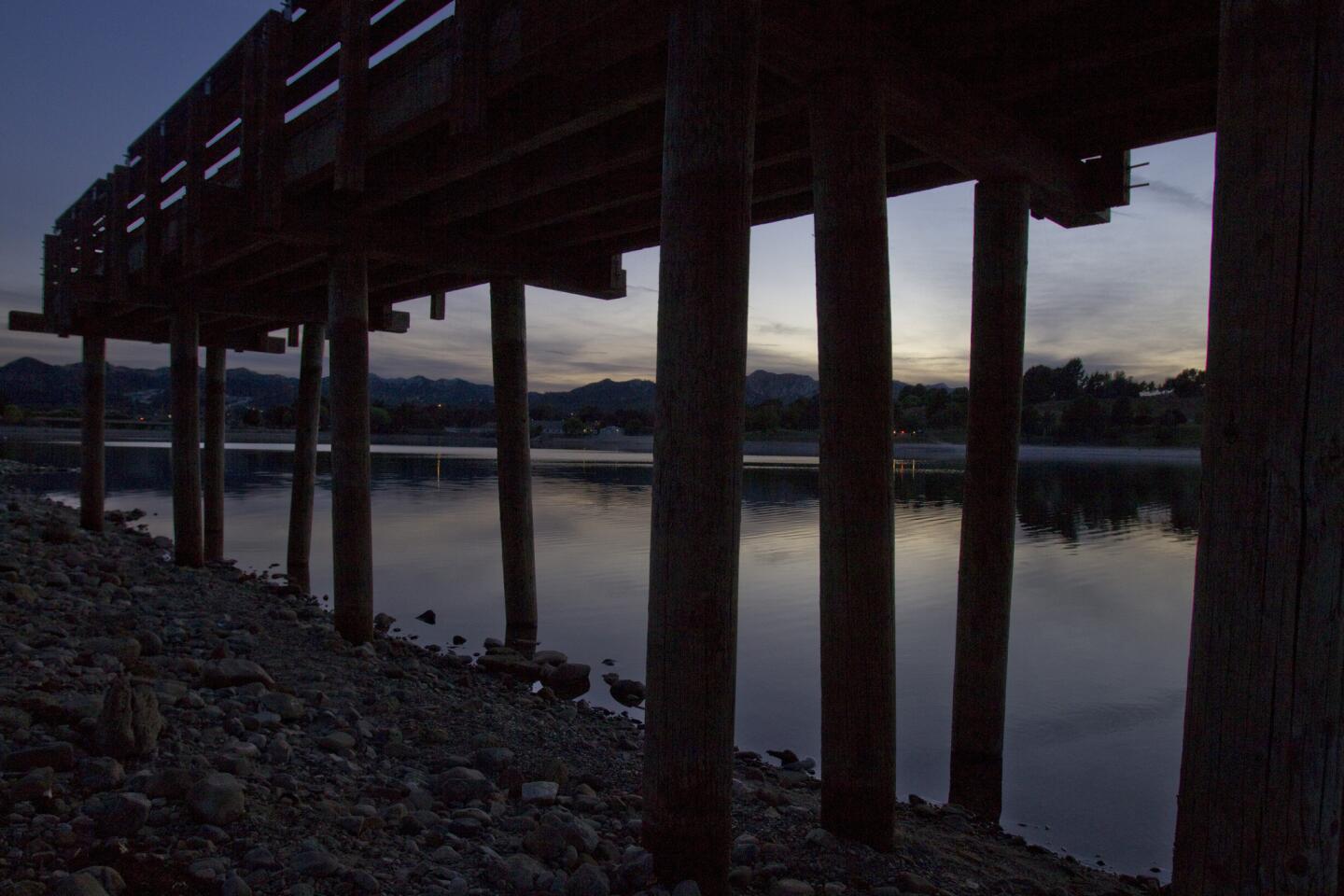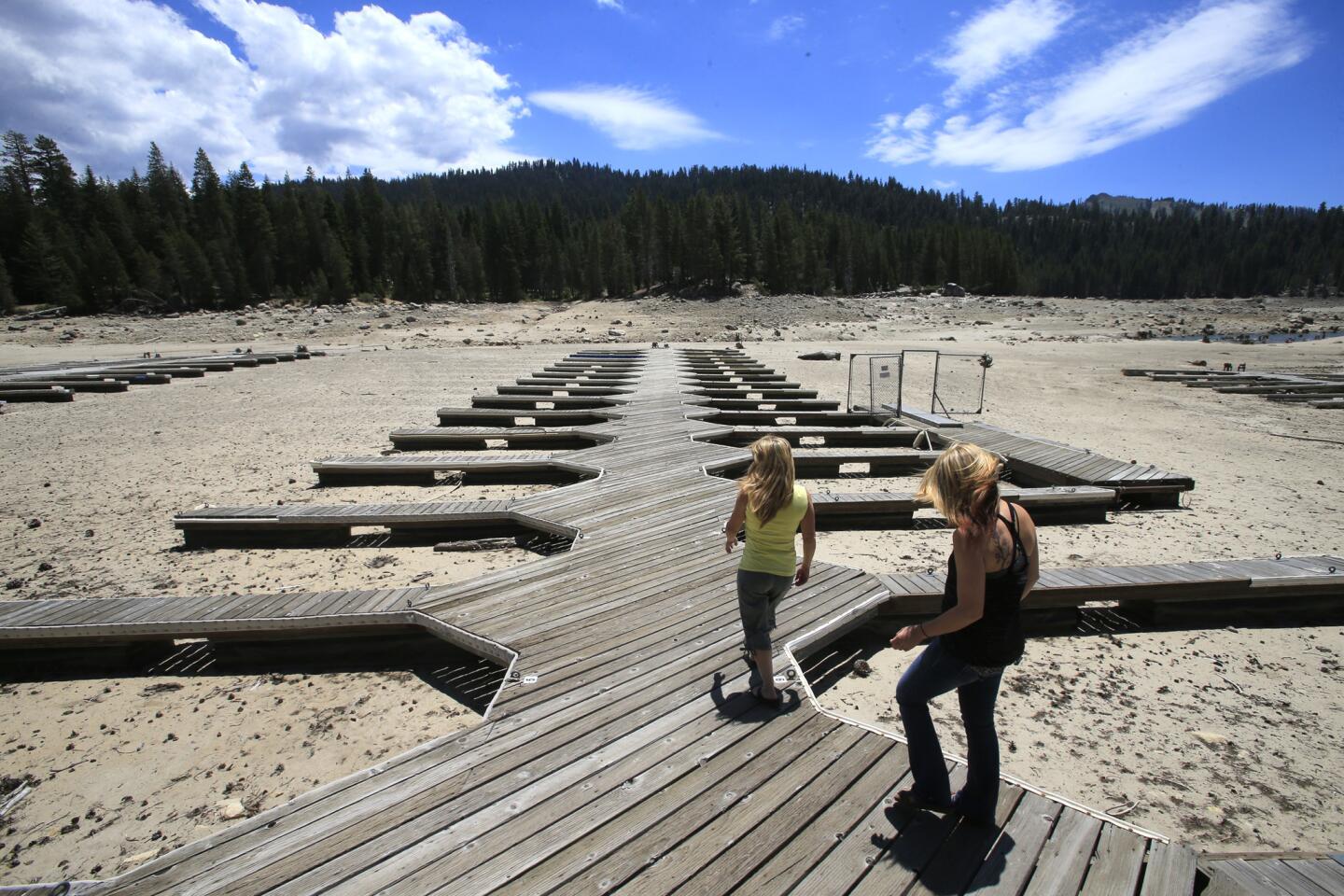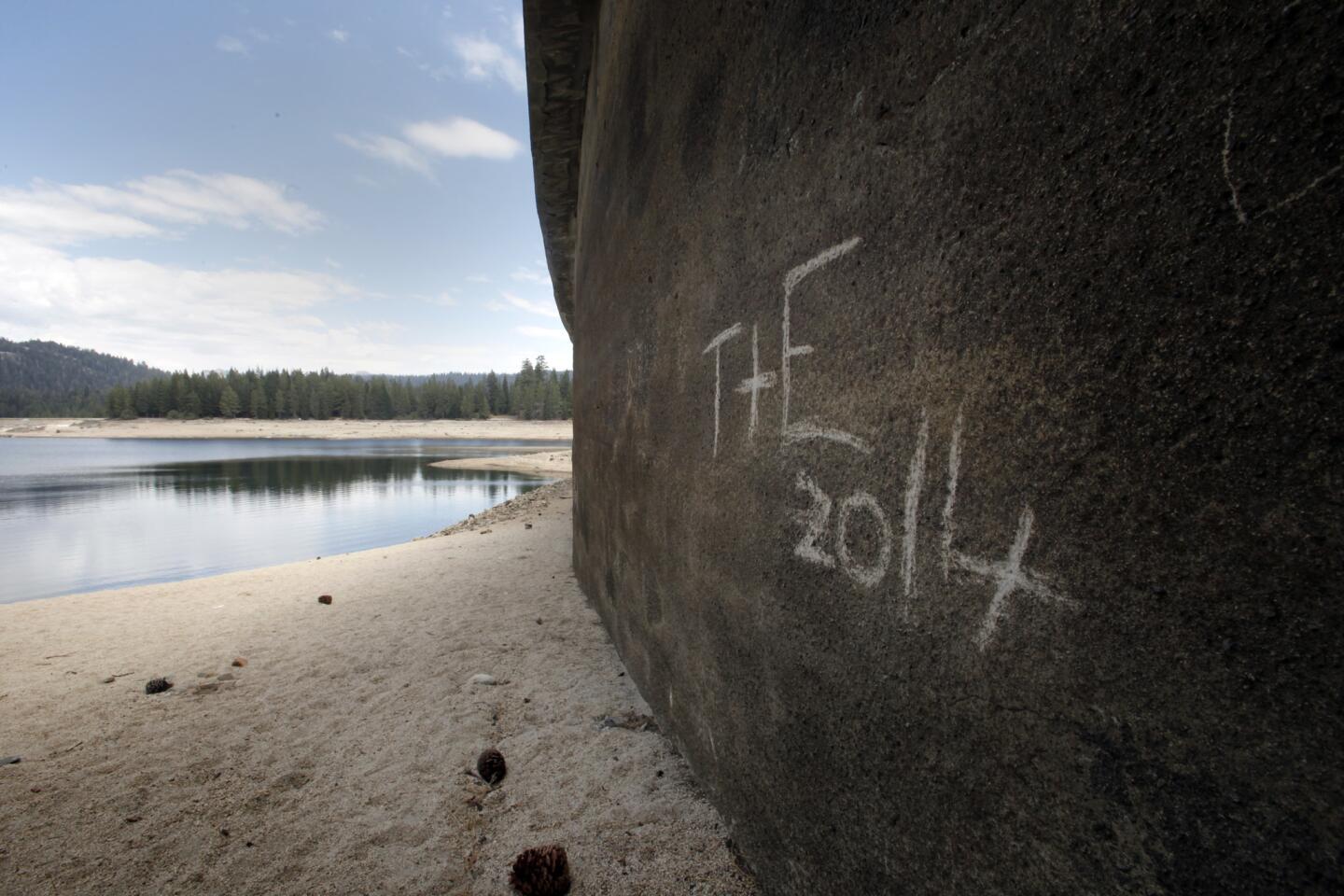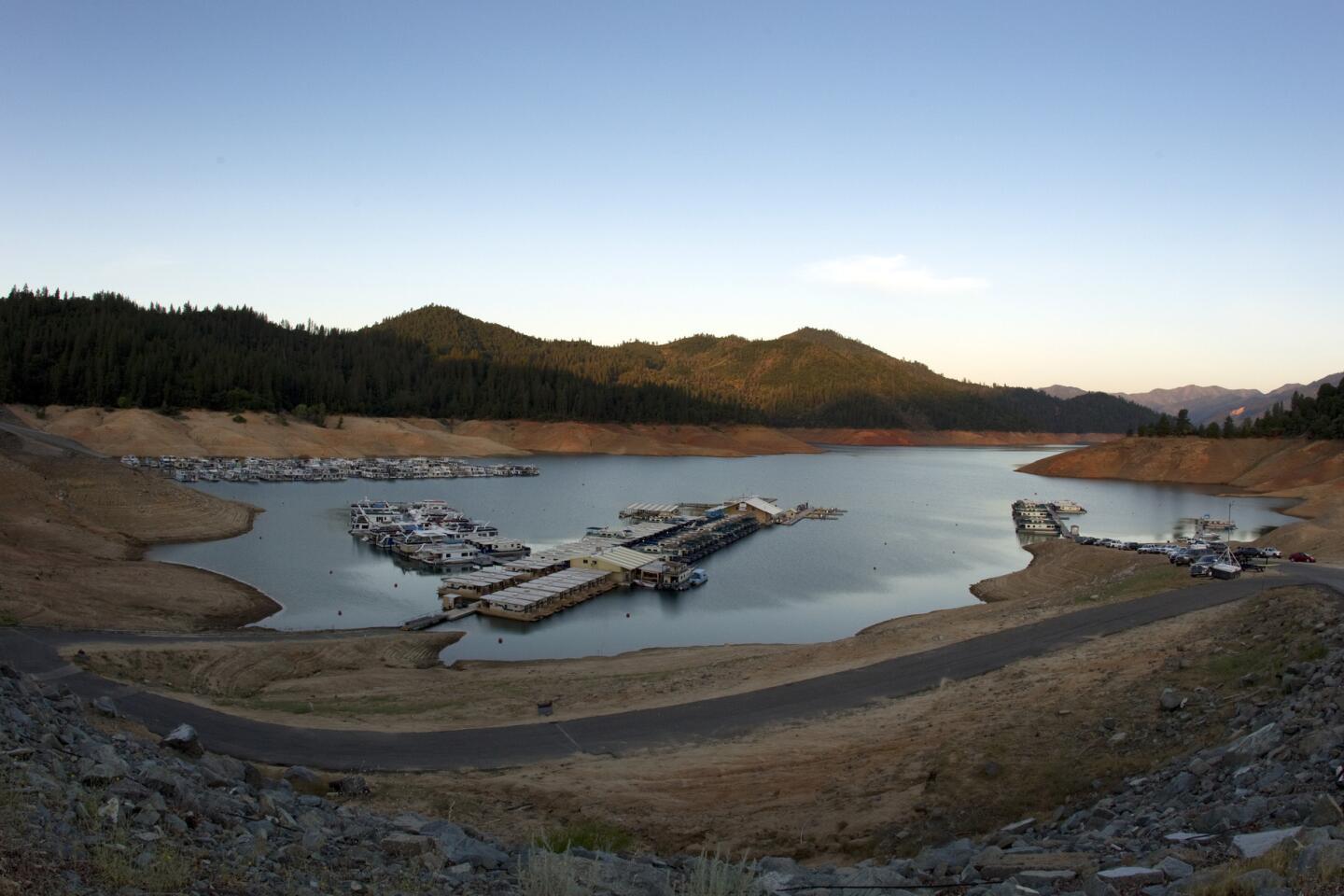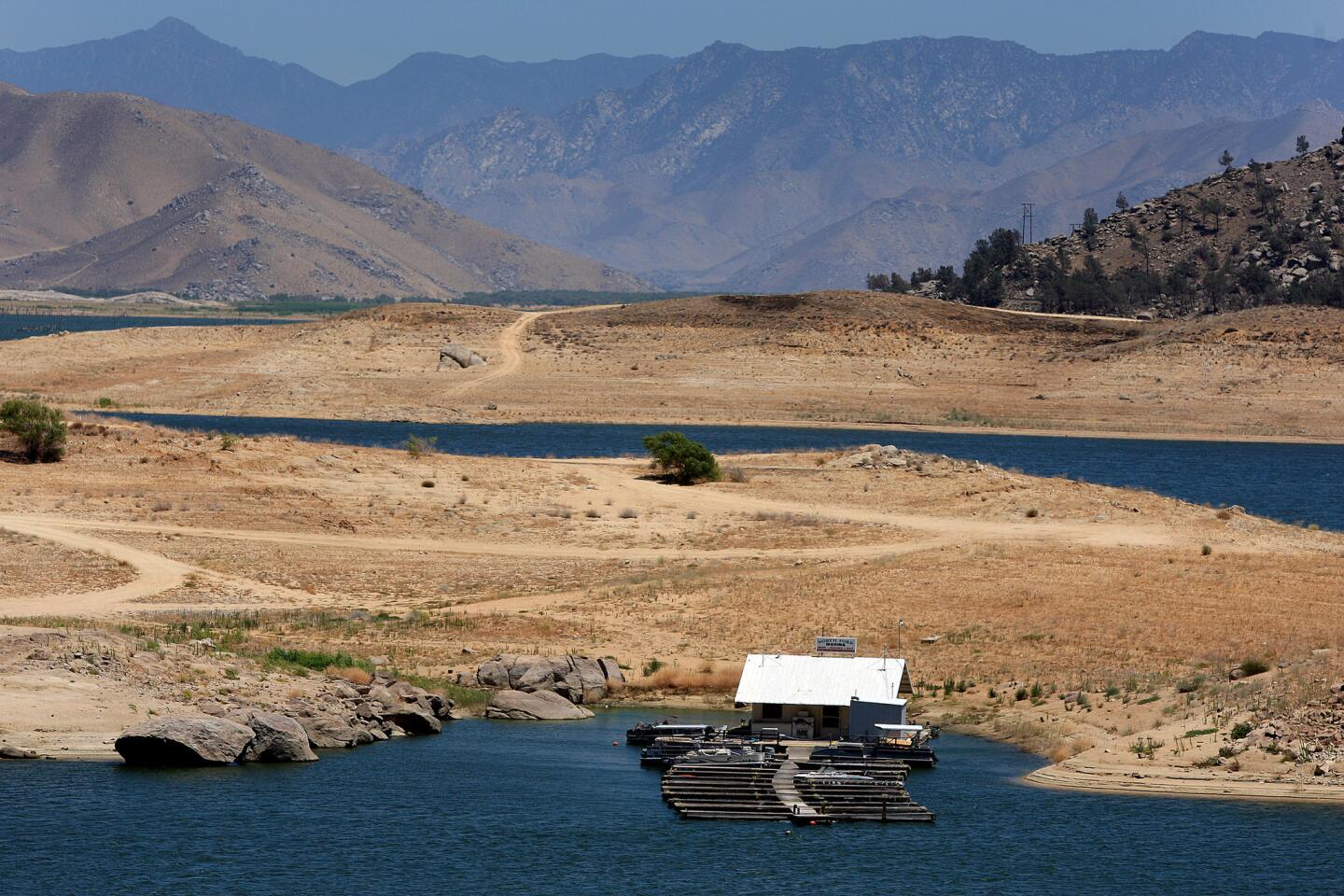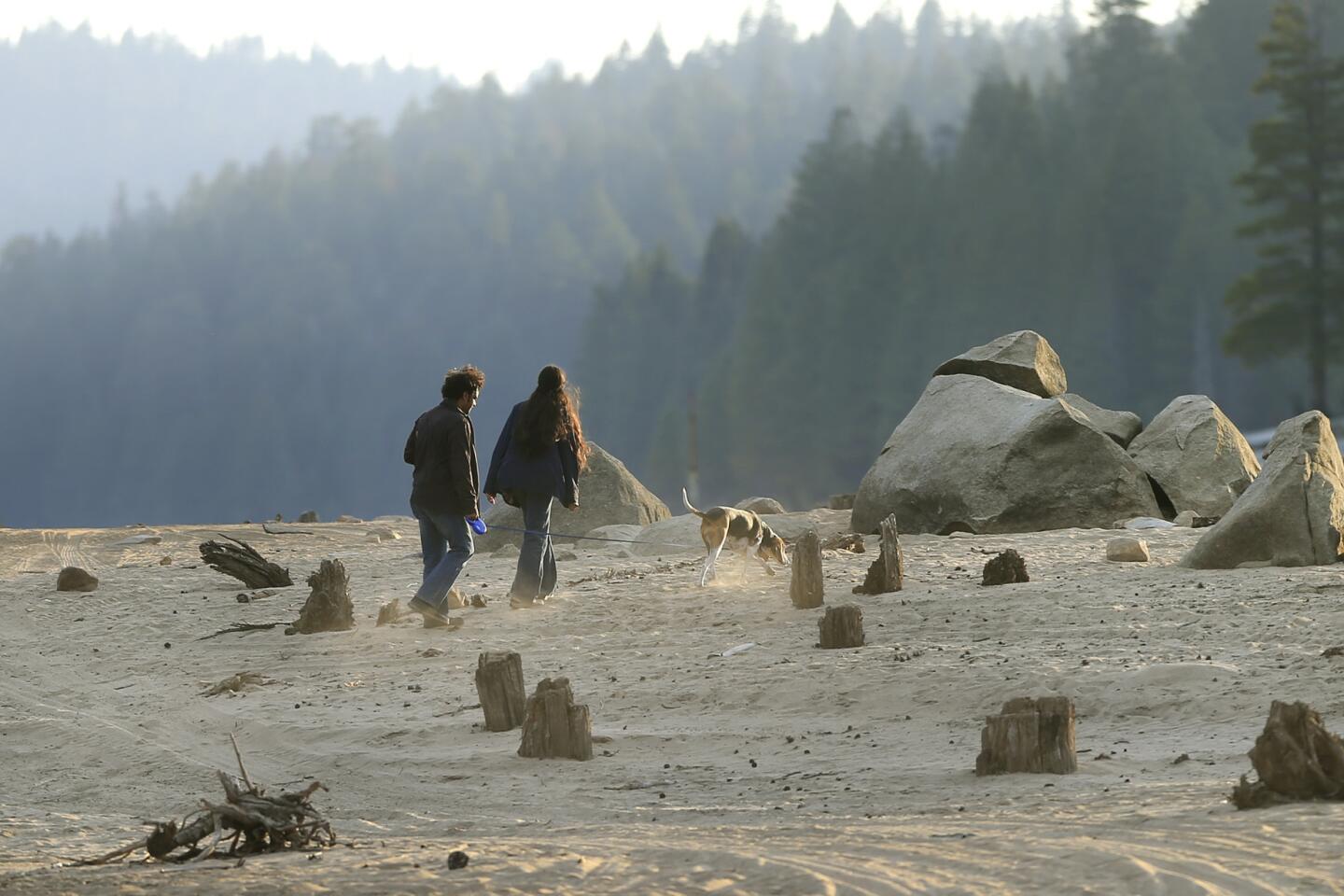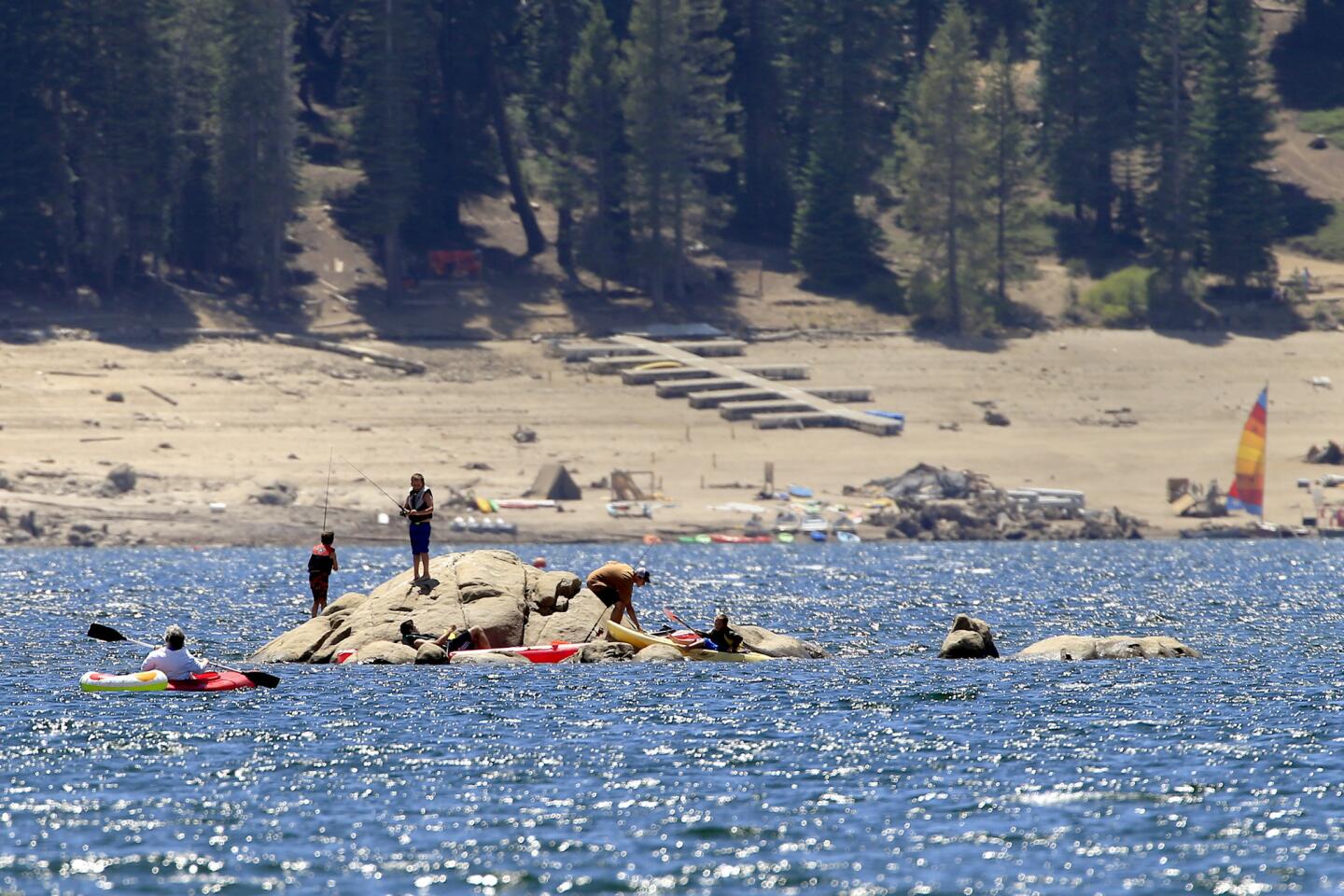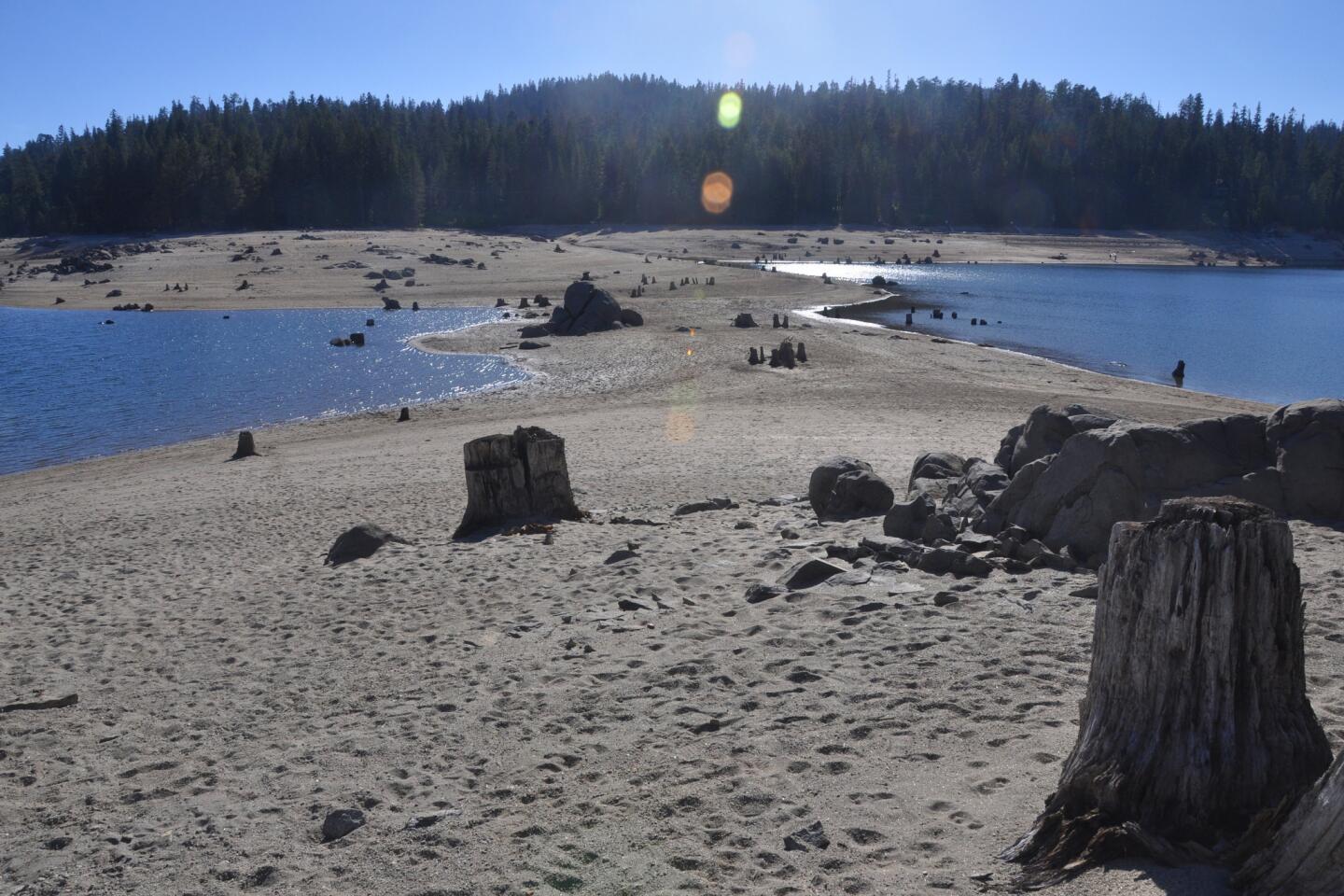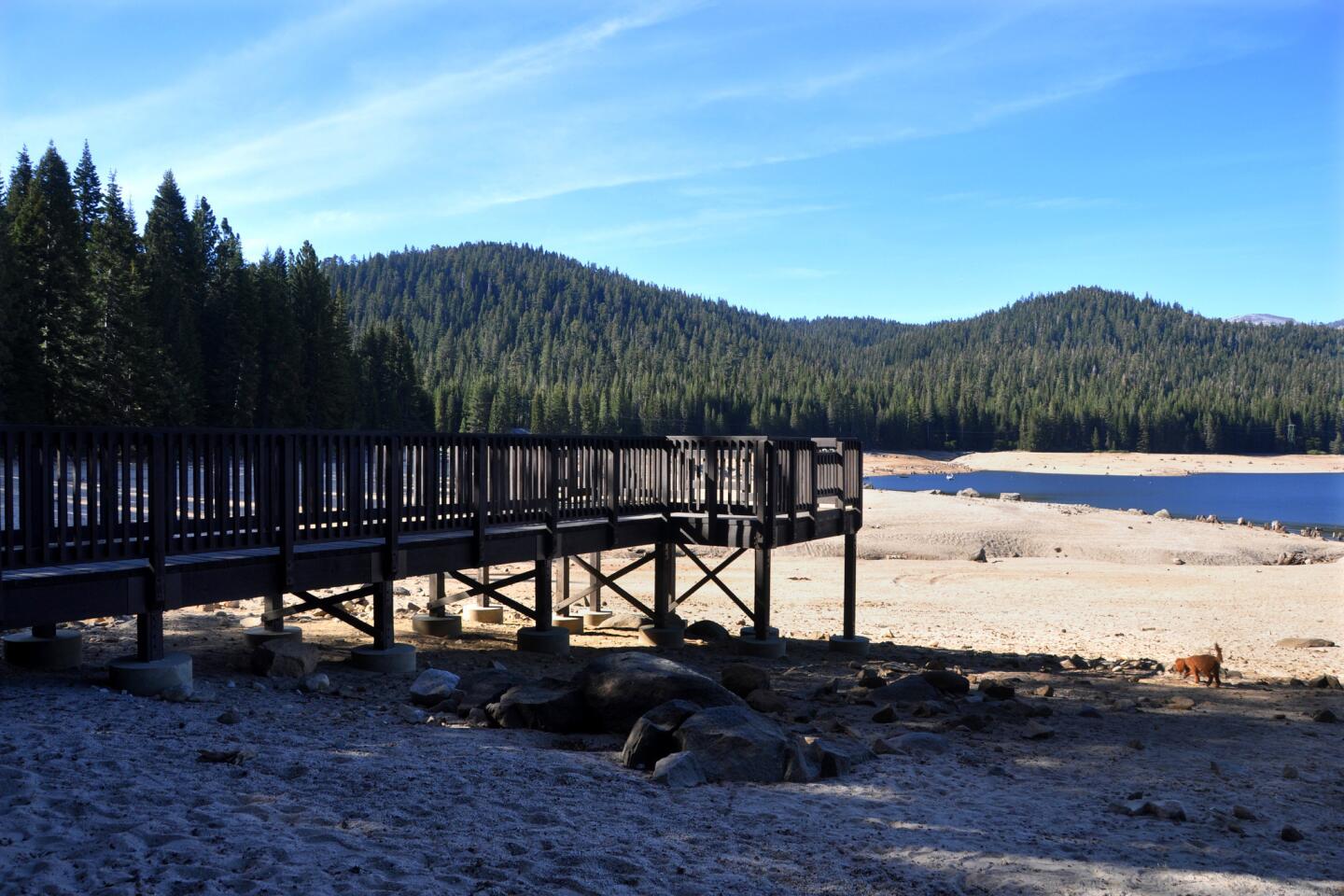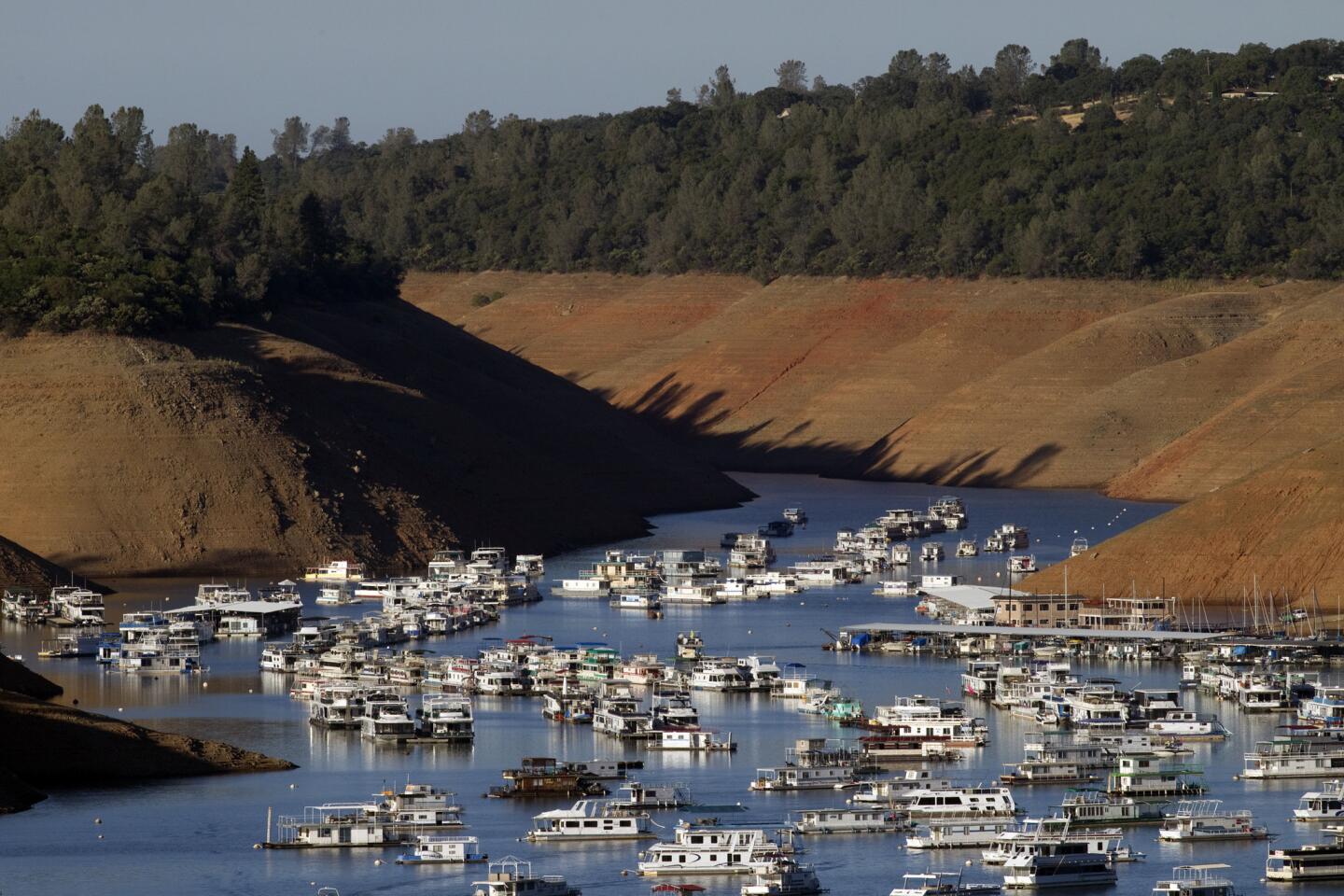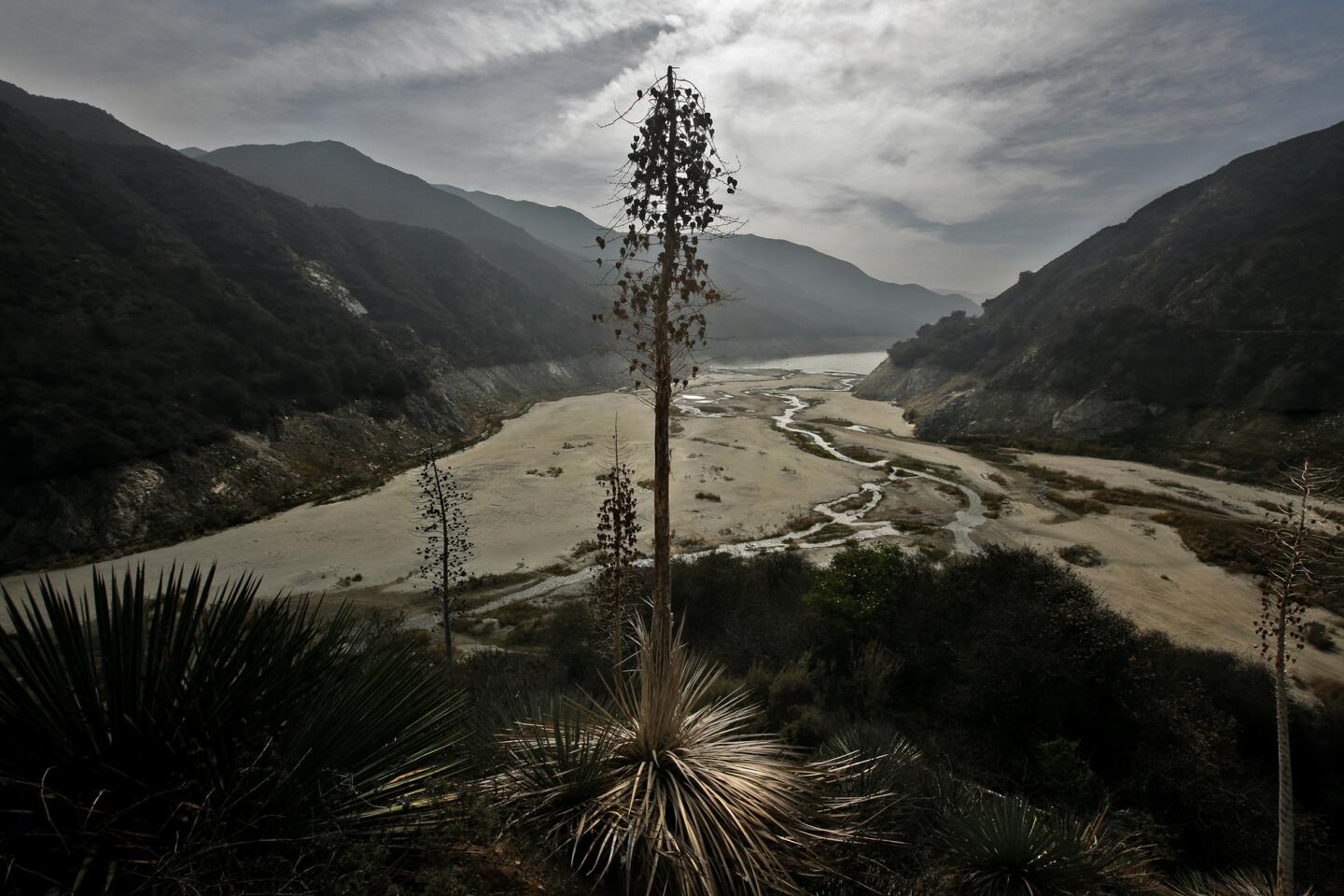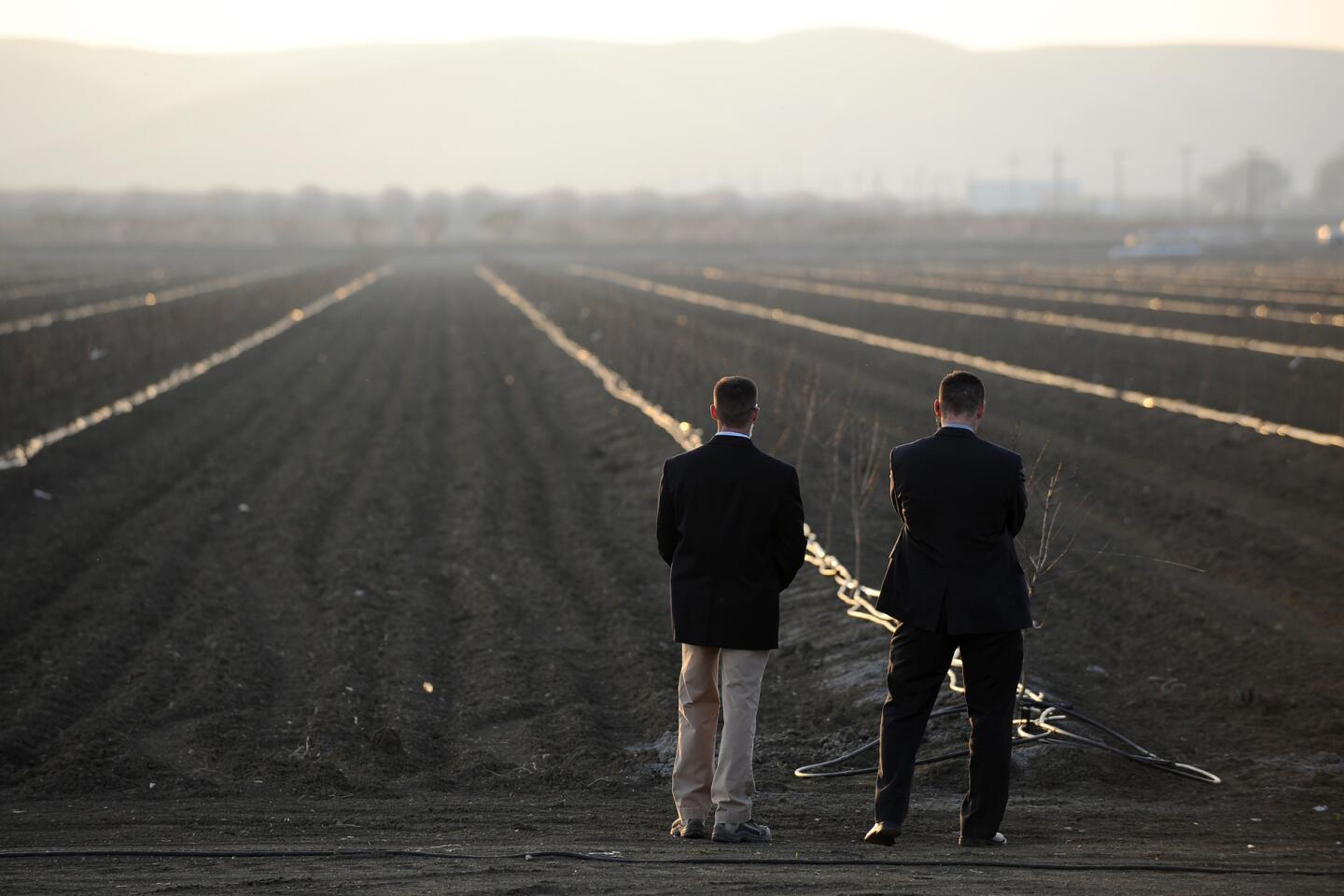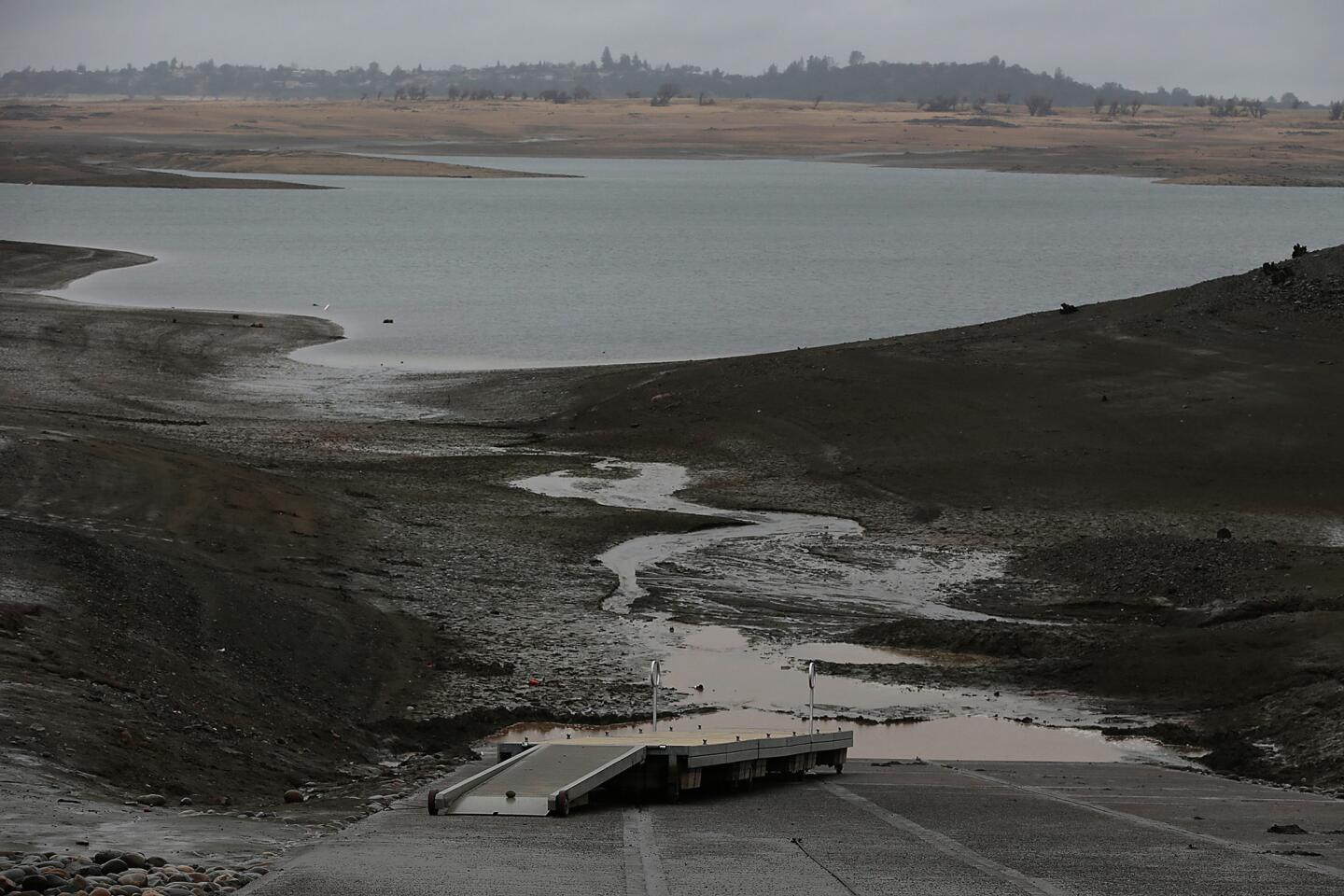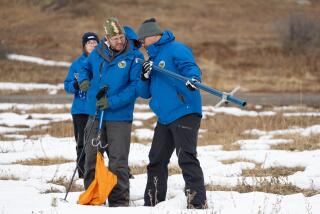In a symbolic moment in California’s slow but steady drought recovery, a state surveyor on Wednesday found several feet of snow in the same Sierra Nevada meadow that was bare and brown just a year ago.
The depth of the snowpack was declared to be just below average, a huge improvement from last year, but still far from enough to declare the drought over.
Around 11 a.m., Frank Gehrke, chief of the California Cooperative Snow Surveys Program, thrust a long silver tube into Phillips Station’s renewed, robust snowpack and, minutes later, told gathered reporters that there was more than 58 inches of snow on the ground.
That snow held 26 inches of water content, he said, just short of average for the date.
“A big improvement compared to last year,” Gehrke said, “but not what we had hoped for.”
The Phillips Station measurement — which officials said was 97% of average — provides data for just one location and therefore is considered more symbolic than definitive. The results from the station about 90 miles east of Sacramento are not necessarily representative of statewide conditions, officials say.
Water officials prefer to use the electronic readings taken remotely at about 100 stations across the Sierra Nevada for a more accurate assessment. The latest readings, taken Wednesday around 8:30 a.m. showed that the water content held by the state’s snowpack was about 24 inches, or 87% of normal.
1/21
Brandon Arthur, 10, crawls out of the gooey muddy tailings left by his father Steve Arthur’s water well drill site in Terra Bella. (Bob Chamberlin / Los Angeles Times)
2/21
Sunrise illuminates previous signs of life amid the dry, steep banks due to drought conditions at Lake Shasta. (Allen J. Schaben / Los Angeles Times)
3/21
Puddles of water are all that remain in some areas of San Gabriel River’s West Fork in the Angeles National Forest. (Allen J. Schaben / Los Angeles Times)
4/21
Pastel colors at dawn reveal a receding Lake Cachuma in Santa Barbara County. (Allen J. Schaben / Los Angeles Times)
5/21
Dusk falls as a lone boater heads out on Lake Shasta near the Lake Shasta Dam. Amid serious drought conditions, Lake Shasta is at only 37% of capacity and is likely to go lower. (Allen J. Schaben / Los Angeles Times)
6/21
The Bridge Bay Marina at Lake Shasta reveals signs of serious drought conditions. (Allen J. Schaben / Los Angeles Times)
7/21
An egret searches for food in a nearly dry canal near Red Bluff in Northern California. (Allen J. Schaben / Los Angeles Times)
8/21
A passing boat is dwarfed by the steep, barren banks of Lake Oroville in Northern California, whose water level has fallen 160 feet. (Allen J. Schaben / Los Angeles Times)
9/21
Pier pilings reach high out of the water at dusk amid extremely low water levels at Castaic Lake Recreation Area. (Allen J. Schaben / Los Angeles Times)
10/21
Owner Elaine Newton walks with her daughter Ashleigh Newton along the family-owned Rancheria Marina docks and boat ramps that are now idle, at Huntington Lake due to historically low water levels caused by the drought. (Mark Boster / Los Angeles Times)
11/21
Chalked initials and the date mark the exposed wall of one of the dams revealed as the water level fell amid the continuing drought at Huntington Lake in Fresno County. (Mark Boster / Los Angeles Times)
12/21
The Bridge Bay Marina at Lake Shasta reveals signs of serious drought conditions June 22. (Allen J. Schaben / Los Angeles Times)
13/21
A nearly-empty boat house and dock are dwarfed by land at the drought-stricken Lake Isabella on July 12. (Allen J. Schaben / Los Angeles Times)
14/21
A couple strolls with their dog along a dusty shoreline that is usually under water at Huntington Lake on July 10. Water is at the lowest level that many in the tiny High Sierra community in Fresno County can remember. (Mark Boster / Los Angeles Times)
15/21
The water level at Huntington Lake is at the lowest that many in the tiny High Sierra community in Fresno County can remember. Most of the boat docks around the lake are now high and very dry. (Mark Boster / Los Angeles Times)
16/21
Low water at Huntington Lake during the drought leaves a bridge of land to the island. Kayaking to the island is usually part of a summer visit. (Diana Marcum / Los Angeles Times)
17/21
An observation deck over the lake is left high and dry as the water level has dropped 50 percent in Huntington Lake this summer. (Diana Marcum / Los Angeles Times)
18/21
Severe drought conditions are evident as hundreds of house boats are dwarfed by steep banks that show the water level down 160 feet from the high water mark at Bidwell Canyon Marina on Lake Oroville on June 21. (Allen J. Schaben / Los Angeles Times)
19/21
Looking toward the San Gabriel River from East Fork Road north of Azuza in February, the San Gabriel reservoir can be seen in the far distance where it has receded more than a mile. (Don Bartletti / Los Angeles Times)
20/21
Secret Service agents look over a dry farm field as President Barack Obama speaks to media about the drought situation in California in February. (Wally Skalij / Los Angeles Times)
21/21
A boat launch at Folsom Lake sits along the banks of the drought-ridden lake in February. (Robert Gauthier / Los Angeles Times)
Though still below average now, the snowpack was in infinitely worse shape a year ago. On April 1, 2015, the statewide snowpack’s water content was just 5% of normal — the lowest ever recorded and the worst in hundreds of years. Data suggested that on average there was one inch of water hidden in the snow, but there was no snow at all on the Phillips Station field.
“This was a dry, dusty field last year,” Gehrke said, adding that Wednesday’s snowpack “seems good because it’s so much better than last year.”
Snowpack is important to California’s hydrology because when it melts, the water feeds into the state’s reservoirs; those reservoirs, in turn, send water to farmers in the Central Valley and to urban dwellers in Southern California. In normal years, it supplies about 30% of the state’s water needs.
The annual April 1 measurement is telling, officials say, because the snowpack traditionally peaks around that time.
Gov. Jerry Brown was on hand for last year’s April 1 snowpack measurement to unveil a historic executive order requiring a 25% reduction in urban water use statewide -- the first such mandatory measure in California history.
There were no dramatic announcements Wednesday. An advisory from Brown’s office sent early in the day said the governor was out of the state.
Asked whether California was still in a drought, Gehrke hedged.
“We’re barely average. It stops that downward slide,” he said. “Now we’re clearly looking at next year, and there are no reliable indicators of what next year will bring.”
For more on the California drought and water, follow me on Twitter @ByMattStevens
ALSO
Who wins with a $15 minimum wage?
Class-action lawsuit targets Palos Verdes Peninsula surfer gang
Apple wants the FBI to reveal how it hacked the San Bernardino killer’s iPhone
